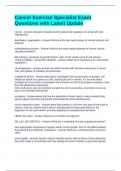Cancer Exercise Specialist Exam
Questions with Latest Update
cancer - Answer-diseases characterized by abnormal regulation of cell growth and
reproduction
duplication, segregation - Answer-What are the two main phases of normal somatic cell
division?
retinoblastoma protein - Answer-What is the major target pathway of human cancer-
causing mutations?
RB pathway, presence of growth factors, ratio of cell surface area to cell volume,
contact inhibition, cell growth inhibition - Answer-What are 5 hypotheses for cell growth
regulation?
carcinogenesis - Answer-process by which normal cells become cancerous; it occurs
over two phases of initiation and promotion
multiple hit theory - Answer-idea that a carcinogen from environment or genetic, will
initiate an attack on a gene in a cell, causing the cell to mutate. If a second attack
(multiple hit) occur from a carcinogen and it knocks out the second gene (mutates), then
that cell will become cancerous
Once both gene sets are knocked out and the cell is cancerous, promotion occurs as
part of uncontrolled cell growth
oncogene - Answer-gene that has the potential to cause cancer; when mutated they
ignore signals that stop cell growth and accelerate tumor development
tumor-suppressor gene - Answer-gene that protects a cell from one step on the path to
cancer; code for proteins which have a dampening ore repressive effect on the
regulation of cell cycle and/or promote apoptosis or programmed cell death
HER2, Ras, Myc - Answer-What are 3 common oncogenes?
RB, p16, p53, BRCA1/2 - Answer-What are 5 examples of tumor-suppressor genes?
lack appropriate responses to signals which control growth, loss of cell differentiation,
decreased drug sensitivity, metastasis - Answer-What are 4 characteristics of cancer
cells?
tumor grade - Answer-system used to classify cancer cells in terms of how abnormal
they look under a microscope and how quickly the tumor is likely to grow and spread
, G1, G4 - Answer-In which tumor grade do tumors resemble normal cells and grow and
multiply slowly? Which do they resemble undifferentiated cells and grow rapidly and
spread quickly?
Staging refers to the extent or severity of the cancer using the TNM system - Answer-
How does cancer staging differ from tumor grades?
tumor, number of nodes, metastasis - Answer-What does TNM stand for?
Stage 1: <2cm, no lymph nodes, mass limited to organ of origin Stage 2: 2-5cm, no
lymph nodes, local spread into surrounding tissues Stage 3: >5cm, possible ipsalateral
lymph nodes invasion, extensive lesions with fixation to deeper structures Stage 4:
distant metastases (contralateral lymph invasion), size Does Not Matter. - Answer-List
the Stages of cancer according to TNM staging criteria?
age, WBC at presentation, presence or absence of CNS involvement - Answer-How are
leukemias staged?
international prognostic index based on age, stage of lymphoma, presence in organs
outside lymph system, performance status, LDH level - Answer-How are lymphomas
staged?
carcinoma - Answer-solid tumors that originate in epithelial cells such as lungs, breast,
kidney, esophagus, stomach, uterus, and intestinal tract (85-90% of all cancers)
sarcoma - Answer-solid tumors that originate in connective tissue such as bone,
muscle, cartilage, and vascular (less than 2% of all cancers)
leukemia - Answer-cancers that result from abnormal white blood cell production in the
bone marrow (2% of all cancers)
lymphoma - Answer-arise from the lymphatic system (5% of all cancers)
CNS cancers - Answer-cancers that begin in the tissues of the brain and spinal cord
Unstable growth control systems, genetics, diminished defense systems, environmental
carcinogenic stressors - Answer-What are the 4 major risk factors for cancer?
surgery - Answer-cancer treatment that works in prevention by removing the organ or
growth that could be malignant, in diagnosis using biopsy tissue for histological
examination, and treatment to remove the cancerous tumor cells and reduce the bulk of
the disease
radiation - Answer-cancer treatment that works as an administered form of photons or
charged particles that damage or destroy malignant cancer cells; kills all cells; most
beneficial for stage III & IV




